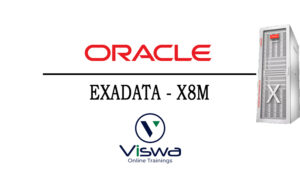Oracle Data Guard 12c | 19c Certification Training
One of the top providers of online IT training worldwide is VISWA Online Trainings. To assist beginners and working professionals in achieving their career objectives and taking advantage of our best services, We provide a wide range of courses and online training.
Learners : 1080
Duration : 25 Days
About Course
These standby databases are kept up to date by our Oracle Data Guard as replicas of the production database. Then, if a scheduled or accidental failure renders the production database unavailable, Oracle Data Guard can move any standby database to the production role, minimizing the outage’s associated downtime. To offer a high level of data protection and availability, Oracle Data Guard can be used in conjunction with conventional backup, restore, and cluster procedures. Enrol today to earn your certification.
Oracle Data Guard Training Course Syllabus
✔ What Is Oracle Data Guard?
✔ Types of Standby Databases
✔ Types of Data Guard Services
✔ Role Transitions: Switchover and Failover
✔ Oracle Data Guard Broker Framework
✔ Choosing an Interface for Administering a Data Guard Configuration
✔ Oracle Data Guard: Architecture(Overview)
✔ Primary Database Processes
✔ Networking Overview
✔ Listener.ora Configuration
✔ Statics vs. Dynamic Registration
✔ Static Entries for Database Duplication and SQL Maintenance
✔ Static Entries for Broker Operations
✔ Oracle Network Configuration Tuning
✔ tnsnames.ora Configuration
✔ Steps to Create a Physical Standby Database
✔ Preparing the Primary Database
✔ FORCE LOGGING Mode
✔ Configuring Standby Redo Logs
✔ Creating Standby Redo Logs
✔ Using SQL to Create Standby Redo Logs
✔ Viewing Standby Redo Log Information
✔ Setting Initialization Parameters on the Primary Database to Control Redo Transport
✔ Oracle Data Guard Broker: Features
✔ Data Guard Broker: Components
✔ Data Guard Broker: Configurations
✔ Data Guard Broker: Management Model
✔ Data Guard Broker: Architecture
✔ Data Guard Monitor: DMON Process
✔ Benefits of Using the Data Guard Broker
✔ Comparing Configuration Management With and Without the Data Guard Broker
✔ Data Guard Broker: Requirements
✔ Data Guard Broker and the SPFILE
✔ Data Guard Monitor: Configuration File
✔ Data Guard Broker: Log Files
✔ Creating a Broker Configuration
✔ Defining the Broker Configuration and the Primary Database Profile
✔ Adding a Standby Database to the Configuration
✔ Enabling the Configuration
✔ Benefits of Implementing a Logical Standby Database
✔ Logical Standby Database: SQL Apply Architecture
✔ SQL Apply Process: Architecture
✔ Preparing to Create a Logical Standby Database
✔ Unsupported Objects
✔ Unsupported Data Types
✔ Checking for Unsupported Tables
✔ Checking for Tables with Unsupported Data Types
✔ Snapshot Standby Databases: Overview
✔ Snapshot Standby Database: Architecture
✔ Converting a Physical Standby Database to a Snapshot Standby Database
✔ Activating a Snapshot Standby Database: Issues and Cautions
✔ Snapshot Standby Database: Target Restrictions
✔ Viewing Snapshot Standby Database Information
✔ Using DGMGRL to View Snapshot Standby Database Information
✔ Converting a Snapshot Standby Database to a Physical Standby Database
✔ Oracle Active Data Guard
✔ Using Real-Time Query
✔ Checking the Standby’s Open Mode
✔ Understanding Lag in an Active Data Guard Configuration
✔ Monitoring Apply Lag: V$DATAGUARD_STATS
✔ Monitoring Apply Lag: V$STANDBY_EVENT_HISTOGRAM
✔ Setting a Predetermined Service Level for Currency of Standby Queries
✔ Configuring Zero Lag Between the Primary and Standby Databases
✔ Data Protection Modes and Redo Transport Modes
✔ Maximum Protection Mode
✔ Maximum Availability Mode
✔ Maximum Performance Mode
✔ Comparing Data Protection Modes
✔ Setting the Data Protection Mode by Using DGMGRL
✔ Setting the Data Protection Mode
✔ Role Management Services
✔ Role Transitions: Switchover and Failover
✔ Switchover
✔ Preparing for a Switchover
✔ Performing a Switchover by Using DGMGRL
✔ Considerations When Performing a Switchover to a Logical Standby Database
✔ Situations That Prevent a Switchover
✔ Using Flashback Database in a Data Guard Configuration
✔ Overview of Flashback Database
✔ Configuring Flashback Database
✔ Using Flashback Database Instead of Apply Delay
✔ Using Flashback Database and Real-Time Apply
✔ Using Flashback Database After RESETLOGS
✔ Flashback Through Standby Database Role Transitions
✔ Fast-Start Failover: Overview
✔ When Does Fast-Start Failover Occur?
✔ Installing the Observer Software
✔ Fast-Start Failover Prerequisites
✔ Configuring Fast-Start Failover
✔ Setting the Lag-Time Limit
✔ Configuring the Primary Database to Shut Down Automatically
✔ Automatic Reinstatement After Fast-Start Failover
✔ Backup and Recovery Considerations in an Oracle Data Guard Configuration
✔ Using RMAN to Back Up and Restore Files in a Data Guard Configuration
✔ Offloading Backups to a Physical Standby
✔ Restrictions and Usage Notes
✔ Using the RMAN Recovery Catalog in Oracle DataGuard Configuration
✔ Creating the Recovery Catalog Registering a Database in the Recovery Catalog
✔ Setting Persistent Configuration Settings
✔ Monitoring a Data Guard Broker Configuration
✔ Viewing the Data Guard Configuration Status
✔ Viewing Log File Details
✔ Oracle DataGuard Metrics
✔ Managing Data Guard Metrics
✔ Viewing Metric Value History
| Live Instructor Based Training With Software |
| Lifetime access and 24×7 support |
| Certification Oriented content |
| Hands-On complete Real-time training |
| Get a certificate on course completion |
| Flexible Schedules |
| Live Recorded Videos Access |
| Study Material Provided |
Oracle Data Guard Training - Upcoming Batches
7th NOV 2022
8 AM IST
Coming Soon
AM IST
5th NOV 2022
8 AM IST
Coming Soon
AM IST
Don't find suitable time ?
CHOOSE YOUR OWN COMFORTABLE LEARNING EXPERIENCE
Live Virtual Training
-
Schedule your sessions at your comfortable timings.
-
Instructor-led training, Real-time projects
-
Certification Guidance.
Self-Paced Learning
-
Complete set of live-online training sessions recorded videos.
-
Learn technology at your own pace.
-
Get access for lifetime.
Corporate Training
-
Learn As A Full Day Schedule With Discussions, Exercises,
-
Practical Use Cases
-
Design Your Own Syllabus Based
Oracle Data Guard Training FAQ'S
The following are the different benefits of using the Oracle Data Guard feature in your environment.
- High Availability.
- Data Protection.
- The off-loading Backup operation to standby database.
- Automatic Gap detection and Resolution in standby database.
- Automatic Role Transition using Data Guard Broker.
The following are the different Services available in the Oracle Data Guard of the Oracle database.
- Redo Transport Services.
- Log Apply Services.
- Role -Transitions.
Below are the protection modes available in DG
- Maximum Protection
- Maximum Availability
- Maximum Performance => This is the default protection mode. It provides the highest level of data protection that is possible without affecting the performance of a primary database. This is accomplished by allowing transactions to commit as soon as all redo data generated by those transactions has been written to the online log.
SELECT PROTECTION_MODE FROM V$DATABASE;
Get ahead in your career by learning Oracle DataGuard through VISWA Online Trainings
- High Availability.
- Load balancing (Backup and Reporting).
- Data Protection.
- Disaster Recovery.
Reviews
 Lavanya Posina2024-09-30To get the SAP S4HANA MM training is really worth from VISWA Technologies. I would like to thank you for providing an excellent training.
Lavanya Posina2024-09-30To get the SAP S4HANA MM training is really worth from VISWA Technologies. I would like to thank you for providing an excellent training. Krishna Grandhi2024-09-19I attended PBCS course. Trainer has good knowledge and his explanation is easy to understand. The support team is also supportive during the training period. Overall experience is good.
Krishna Grandhi2024-09-19I attended PBCS course. Trainer has good knowledge and his explanation is easy to understand. The support team is also supportive during the training period. Overall experience is good. Siddhartha Mothukuri2024-09-10Learnt SAP EWM and it has been a really good experience with VISWA Online Trainings and trainer has been excellent in terms of his understanding in business as well as SAP. Thank you
Siddhartha Mothukuri2024-09-10Learnt SAP EWM and it has been a really good experience with VISWA Online Trainings and trainer has been excellent in terms of his understanding in business as well as SAP. Thank you Lakshmiprasanna Annem2024-08-01Thanks chaitanya arrange for sap bw on Hana job support. I will recommend definitely anyone.
Lakshmiprasanna Annem2024-08-01Thanks chaitanya arrange for sap bw on Hana job support. I will recommend definitely anyone. VINOD reddy2024-07-23Amazing Oracle Transportation Management (OTM) training! Definitely recommend.
VINOD reddy2024-07-23Amazing Oracle Transportation Management (OTM) training! Definitely recommend. Arvind P2024-06-28Good institute. Very responsible. As a trainer I got a good experience with them
Arvind P2024-06-28Good institute. Very responsible. As a trainer I got a good experience with them srinivasulu p2024-05-14I have recently enrolled azure cloud security training. There was lots of interaction sessions. It was best online learning platform.
srinivasulu p2024-05-14I have recently enrolled azure cloud security training. There was lots of interaction sessions. It was best online learning platform. Mahendra Reddy2024-05-14I would definitely recommend it anyone looking for generative AI course. This is friendly course thanks phani kumar
Mahendra Reddy2024-05-14I would definitely recommend it anyone looking for generative AI course. This is friendly course thanks phani kumar




